Komentáře / Otázky (109)
![]() Barbara Seppoloni napsala:
Barbara Seppoloni napsala:
Buonasera posso realizzare il modello con i ferri dritti? Grazie
10.03.2025 - 21:23Odpověď DROPS Design :
Buonasera Barbara, il modello è lavorato in piano, per cui può utilizzare anche i ferri dritti. Buon lavoro!
18.03.2025 - 20:40
![]() Betsy napsala:
Betsy napsala:
This is for pattern Dove 150-12. On the bottom of page 2, the last line, what do you mean by plaited? Is that the same at cables?
12.02.2024 - 01:39Odpověď DROPS Design :
Hi Betsy, Yes, that means to cable. Happy knitting!
12.02.2024 - 08:05
![]() Luz Uribe napsala:
Luz Uribe napsala:
Hola, empecé el patrón por la espalda y terminé la primera serie de A1, A2 y no sé cómo continuar... no entiendo "cuando los puntos de A1 y A2 se han cruzado 10 veces verticalmente..." No hay una foto de la parte de atrás del tejido... me quedo suspendida mientras llega su respuesta, gracias!
06.01.2024 - 01:43Odpověď DROPS Design :
Hola Luz, quiere decir cuando se hayan trabajado 10 trenzas en A.1 y A.2. Entonces continúas sin aumentos ni trenzas.
08.01.2024 - 00:12
![]() Francoise Viallard napsala:
Francoise Viallard napsala:
Bonjour, je souhaiterai faire ce modèle 3 fois que je detricote car il me manque des mailles je comme avec 130 et avec les mailles torses et les mailles ensembles sans jetées sauf celle tous les 2 rangs il me manque 4 mailles. Je ne comprends pas trop, je ne suis pas une novice. Pouvez vous m'expliquer SVP Merci
15.12.2023 - 20:08Odpověď DROPS Design :
Bonjour Mme Viallard, quand vous tricotez les diagrammes, votre nombre total de mailles doit rester le même, vous allez juste diminuer le nombre de mailles jersey tricotées entre A.1 et A.2, suivez bien les diagrammes (mettez éventuellement un marqueur après A.1 et avant A.2 pour mieux vous repérer dans le nombre de mailles et vérifier après chaque rang). Bon tricot!
18.12.2023 - 08:12
![]() Lea napsala:
Lea napsala:
Bonjour il est noté après avoir croisé 10 fois au total.... sur le diagramme il n'y a que 4 croisement comment faire la suite? doit je recommencer depuis le bas du diagramme ? Merci de votre réponse
23.09.2023 - 08:27Odpověď DROPS Design :
Bonjour Lea, continuez le motif exactement comme avant pour les mailles point mousse et les augmentations et continuez les torsades jusqu'à ce que vous ayez fait 10 torsades au total en hauteur. Bon tricot!
25.09.2023 - 08:33
![]() ANNA MARIA GUZZI napsala:
ANNA MARIA GUZZI napsala:
Grazie per risposta alla richiesta di foto del dietro. tuttavia dalla vs foto si evidenzia che ad un certo punto si interrompono gli intrecci , ma continuano gli aumenti con gettato . Nella scheda invece dite di NON eseguirli sia per davanti che dietro. Giusto per vs evidenza sulla scheda con traduzione in italiano . Saluti.
09.07.2023 - 16:24
![]() ANNA MARIA GUZZI napsala:
ANNA MARIA GUZZI napsala:
Buonasera . per favore posso vedere una foto della parte dietro del poncho donna Dove 150-12?grazie mille - anna
01.07.2023 - 20:50Odpověď DROPS Design :
Buongiorno Anna Maria, purtroppo non abbiamo altre foto disponibili del modello. Buon lavoro!
05.07.2023 - 08:24
![]() VALLEE napsala:
VALLEE napsala:
Bonjour, je ne comprend pas ce que veut dire pour le dos : "quand on a croisé un total de 9 fois en hauteur les mailles dans A1 et A2 de chaque côté, continuer....... Merci de votre aide.
23.01.2023 - 16:13Odpověď DROPS Design :
Bonjour Mme Vallee, cela signifie, lorsque vous avez tricoté les torsades de A.1 et A.2 9 fois (= vous aurez croisé les mailles de A.1/A.2 9 fois au total). Bon tricot!
23.01.2023 - 16:28
![]() Matera napsala:
Matera napsala:
Je souhaiterai faire ce joli modèle plus long, comment dois je faire. Ne plus faire de jeté et arrêtez les torsades et continuez en jersey. Merci pour votre réponse
21.01.2023 - 14:24Odpověď DROPS Design :
Bonjour Mme Matera, nous ne sommes malheureusement en mesure de pouvoir adapter chacun de nos modèles à chaque demande. N'hésitez pas à contacter votre magasin, un forum ou demandez conseil à d'autres tricoteuses via notre DROPS Workshop. Merci pour votre compréhension.
23.01.2023 - 08:58
![]() Matera napsala:
Matera napsala:
Bonjour, je voudrais faire le modèle plus long de 20 cm comment je dois procéder, je vous remercie
15.01.2023 - 10:36
Dove#dovecardigan |
||||||||||||||||
 |
 |
|||||||||||||||
DROPS pončo s copánkovým a plastickým vzorem pletené z příze "Nepal" a "Kid-Sik". Velikost: S-XXXL.
DROPS 150-12 |
||||||||||||||||
|
VROUBKOVÝ VZOR: Pleteme stále hladce, lícové i rubové řady. 1 vroubek = 2 řady hladce. VZOR: Viz schémata A.1 a A.2. Zobrazeny jsou všechny řady vzoru nahlížené z lícové strany. KNOFLÍKOVÉ DÍRKY: Knoflíkové dírky vyplétáme v pravé léze. 1 dírka = 3. a 4. oko od předního okraje légy spleteme hladce a 1x nahodíme. Knoflíkové dírky vyplétáme v těchto rozestupech: Velikost S/M: 7, 15, 23, 31, 39 a 47 cm. Velikost L: 8, 16, 25, 33, 42 a 50 cm. Velikost XL/XXL: 7, 16, 25, 34, 43 a 52 cm. Velikost XXXL: 8, 18, 27, 37, 46 a 55 cm. ---------------------------------------------------------- PONČO ZADNÍ DÍL: Pleteme v řadách na kruhové jehlici. Na kruhovou jehlici č.6 nahodíme 1 vláknem příze Nepal + 1 vláknem příze Kid-Silk (= dvojitou přízí) 108-112-118-122 ok a upleteme 3 vroubky vroubkovým vzorem – viz výše. Pak pleteninu převedeme na kruhovou jehlici č.7 a následující lícovou řadu pleteme takto: 4 oka vroubkovým vzorem, 3 oka hladce, 3 oka obrace, 88-92-98-102 ok lícovým žerzejem, SOUČASNĚ přidáme 12 ok – každé z prvních 6 ok rozpleteme na 2 a stejně tak každé z posledních 6 ok lícovým žerzejem rozpleteme na 2 (= 12 přidaných ok), 3 oka obrace, 3 oka hladce, 4 oka vroubkovým vzorem = na jehlici máme celkem 120-124-130-134 ok. Následující rubovou řadu pleteme takto: 4 oka vroubkovým vzorem, 3 oka obrace, 3 oka hladce, 100-104-110-114 ok lícovým žerzejem, 3 oka hladce, 3 oka obrace, 4 oka vroubkovým vzorem. Pokračujeme lícovou řadou: vzor A.1 (= 22 ok), 76-80-86-90 ok lícovým žerzejem, vzor A.2 (= 22 ok). V tomto rozvržení vzorů pokračujeme, tj. v každé 2. řadě se středová sekvence lícového žerzeje zmenšuje, zatímco sekvence vzoru A.1 a A.2 se zvětšují – celkový počet ok se ale nemění. Když máme na každé straně vzor A.1 a A.2 křížený celkem 10-11-11-12x (na výšku), pokračujeme v pletení vzorů A.1 a A.2 bez nahození a copánků (nad copánky pleteme lícovým žerzejem). Ve výši 53-56-59-62 cm uzavřeme pro průkrčník prostředních 16-18-18-20 ok a obě náramenice dokončíme odděleně. V následující řadě uzavřeme na obou stranách průkrčníku ještě 1 oko = 51-52-55-56 ok každé náramenice. Pokračujeme až do výše 55-58-61-64 cm a pak všechna oka uzavřeme. Stejným způsobem dopleteme i druhou náramenici. PRAVÝ PŘEDNÍ DÍL: Na kruhovou jehlici č.6 nahodíme 1 vláknem příze Nepal + 1 vláknem příze Kid-Silk (= dvojitou přízí) 59-61-64-66 ok (včetně 5 ok légy u předního okraje) a upleteme 3 vroubky vroubkovým vzorem. Pak pleteninu převedeme na kruhovou jehlici č.7 a následující lícovou řadu pleteme takto: 5 ok légy vroubkovým vzorem, 44-46-49-51 ok lícovým žerzejem, SOUČASNĚ přidáme 6 ok – každé z posledních 6 ok lícovým žerzejem rozpleteme na 2 (= 6 přidaných ok), 3 oka obrace, 3 oka hladce, 4 oka vroubkovým vzorem = na jehlici máme celkem 65-67-70-72 ok. Následující rubovou řadu pleteme takto: 4 oka vroubkovým vzorem, 3 oka obrace, 3 oka hladce, 50-52-55-57 ok lícovým žerzejem, 5 ok légy vroubkovým vzorem. Pokračujeme lícovou řadou: 5 ok légy vroubkovým vzorem, 38-40-43-45 ok lícovým žerzejem, pak vzor A.2 (= 22 ok). V tomto rozvržení vzorů pokračujeme, tj. sekvence lícového žerzeje u předního okraje se zmenšuje, zatímco sekvence vzoru A.2 se zvětšuje (celkový počet ok se ale nemění). Pamatujeme na vyplétání KNOFLÍKOVÝCH DÍREK v léze – viz výše. POZN.: Když máme vzor A.2 křížený celkem 9-10-10-11x (na výšku), pokračujeme v pletení vzoru A.2 bez nahození a copánku (nad copánkem pleteme lícovým žerzejem). SOUČASNĚ ve výši asi 47-50-52-55 cm (končíme 1 řadou po poslední knoflíkové dírce, copánkové křížení vzoru A.2 je dokončeno) odložíme pro průkrčník prvních 10-11-11-12 ok od předního okraje na pomocnou jehlici (oka nejprve upleteme a teprve pak je odkládáme – nemusíme tedy stříhat přízi). Průkrčník dále tvarujeme – uzavíráme na jeho okraji na začátku každé řady 1x 2 oka a 2x 1 oko = 51-52-55-56 ok náramenice. Pokračujeme do výše 55-58-61-64 cm – když je díl stejně vysoký, jako zadní, všechna oka uzavřeme. LEVÝ PŘEDNÍ DÍL: Nahodíme a pleteme stejně jako pravý přední díl, jen zrcadlově převrácený. Namísto vzoru A.2 pleteme vzor A.1. DOKONČENÍ: Sešijeme náramenice. Na dolní okraj lemu vroubkovým vzorem přišijeme 2 ozdobné knoflíky ve vzdálenosti 3 a 9 cm od okraje na každé straně (přišíváme je skrze obě vrstvy pleteniny, takže vlastně sešijeme přední a zadní díl). LEM PRŮKRČNÍKU: Po obvodu průkrčníku nabereme z lícové strany kruhovou jehlicí č.6 dvojitou přízí (tj. po 1 vláknu od každého druhu) asi 60 až 70 ok (včetně odložených ok předních dílů z pomocných jehlic) a upleteme v řadách 3 vroubky vroubkovým vzorem. Pak všechna oka v rubové řadě volně hladce uzavřeme. |
||||||||||||||||
Vysvětlivky ke schématu |
||||||||||||||||
|
||||||||||||||||
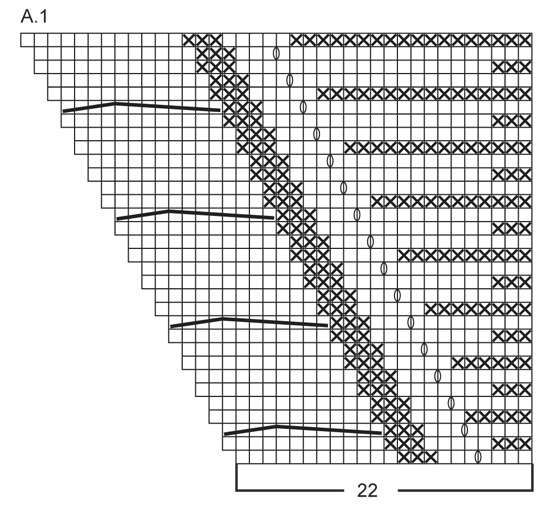
|
||||||||||||||||
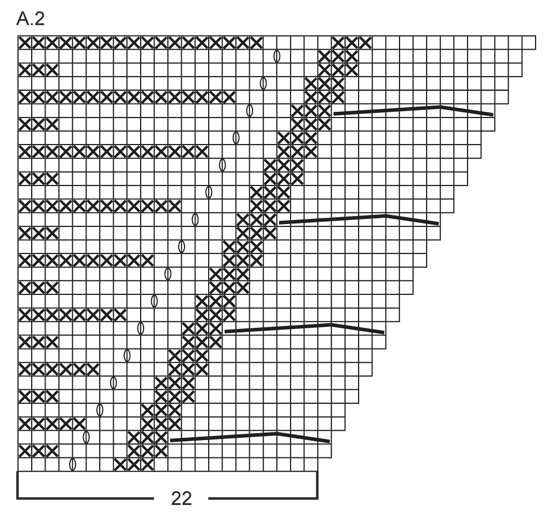
|
||||||||||||||||
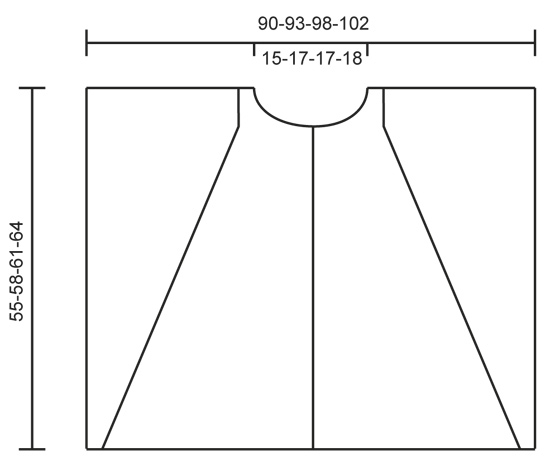
|
||||||||||||||||
Dokončili jste tento model?Pak označte své fotky tagem #dropspattern #dovecardigan nebo je pošlete do galerie #dropsfan. Potřebujete s tímto návodem poradit?Otevřete-li si návod na stránce garnstudio.com, najdete tam 20 výukových video-ukázek, Komentáře/Dotazy a další užitečné informace. © 1982-2025 DROPS Design A/S. Vyhrazujeme si veškerá práva. Tento dokument, včetně všech jeho dílčích částí, podléhá autorským právům. Podrobnější komentář k možnostem užití našich návodů najdete dole pod každým návodem na našich stránkách. |
||||||||||||||||








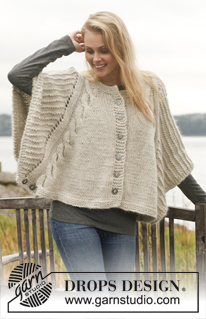



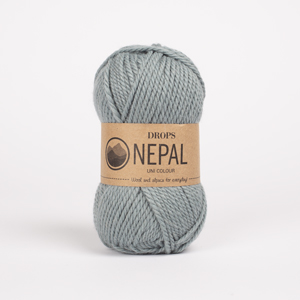
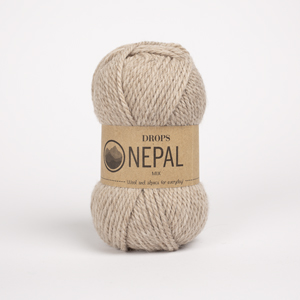
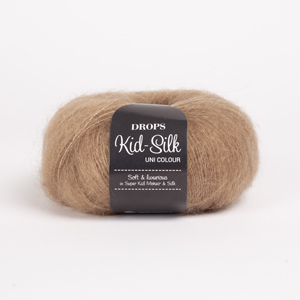
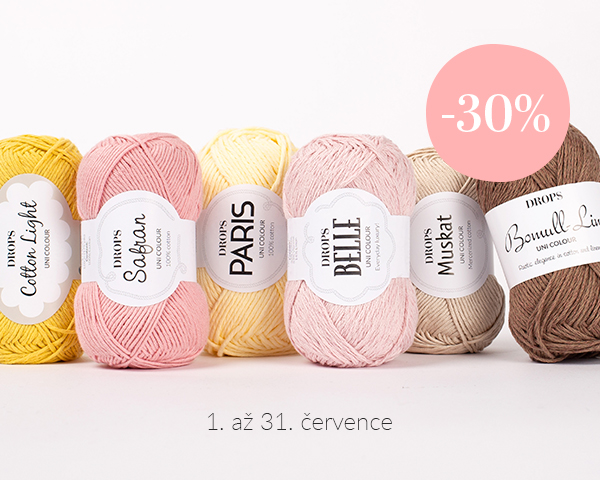







































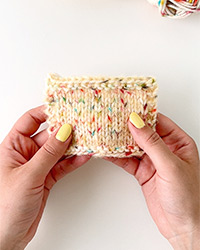
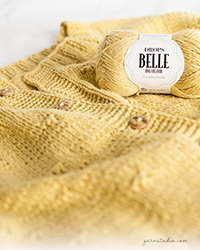
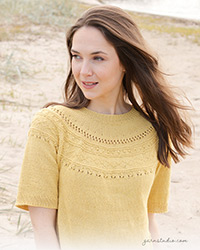
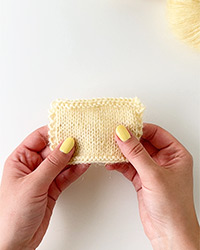

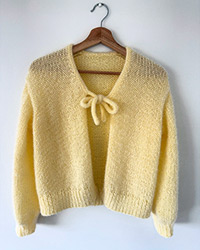
Přidejte komentář k návodu DROPS 150-12
Rádi bychom věděli, co si o tomto modelu myslíte!
Pokud se chcete na něco zeptat, dbejte prosím na to, abyste ve formuláři níže vybrali správnou kategorii - díky tomu se dříve dozvíte, co potřebujete vědět. Povinná pole jsou označena *.